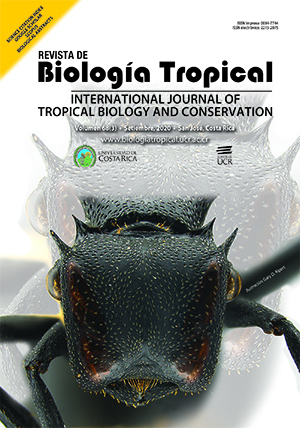Abstract
Introduction: Thanks to filtration by foliage, urban trees have a crucial role in air depuration. However, the exposure to pollutants could reduce their health and physiological performance, mainly because of low access to light and clogging of stomata by particulate matter. Objective: The accumulation of particulate matter on leaves (PMAL) and physiological traits of five urban tree species (Croton bogotanus Cuatrec., Eugenia myrtifolia Sims., Ficus soatensis Dugand, Schinus mole L., and Sambucus nigra L.) were quantified in sixty points in Bogotá, with the aims to (1) build a model explaining the PMAL based on traffic variables, (2) establishing the effect of vehicle pollution on physiological and phytosanitary variables, and (3) to evaluate the susceptibility of seedlings and trees to vehicle pollution. Methods: The physiological parameters: photochemical efficiency, stomatal conductance, chlorophyll content, leaf area, and specific leaf mass were measured and correlated with phytosanitary condition, PMAL and traffic variables: number of lanes, vehicular flow and tree-to-avenue distance. Additionally, tree physiological responses were measured in control, residential streets (RS), low traffic avenues (LTA), and high traffic avenues (HTA), and these last were compared with physiology of seedlings planted by three months in HTA. Results: PMAL was strongly associated with physiological responses. Ficus soatensis and C. bogotanus were the species with the maximum and the minimum PMAL. The exposure to traffic increased the photochemical efficiency and specific leaf mass, which could be related to the enrichment of nitrogen and atmospheric CO2. The stomatal conductance followed a bell pattern of low gas exchange in control sites, high values in RS and LTA, and decreasing again in HTA, which suggests an optimization in CO2 fixation at intermediate levels of pollution and susceptibility to stomatal clogging by extreme vehicle emissions. The chlorophyll a/b ratio, leaf area, and specific leaf mass were significantly related to the severity of leaf symptoms, and S. molle was the species with the healthiest leaves in HTA. Seedlings were more susceptible to pollution than trees, and fruits size and seedlings growth were affected by vehicular pollution. Conclusions: Ficus soatensis optimizes particle filtration and C. bogotanus is ideal for planting in HTA, although only as saplings. By contrast, the fast-growing E. myrtifolia and S. nigra seedlings should not be planted in HTA because of susceptibility of pigment contents, leaf area, and stomatal conductance to pollutants. Finally, because of its persistent high stomatal conductance and its low leaf symptoms, S. molle is the species with the best adaptation to vehicle pollution. A complete analysis of interactions among traffic, physiology, and health will help to improve the urban forestry planning.
##plugins.facebook.comentarios##

This work is licensed under a Creative Commons Attribution 4.0 International License.
Copyright (c) 2020 CAROLINA RAMOS


